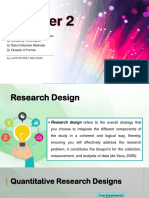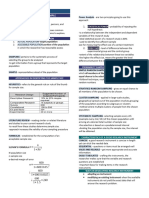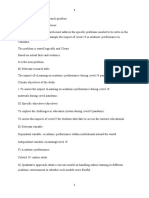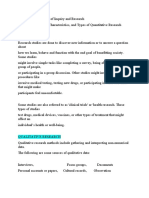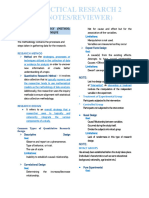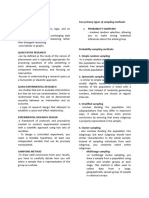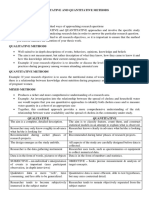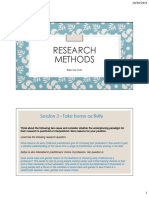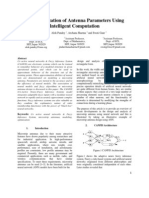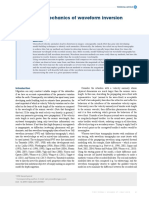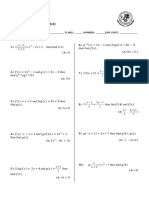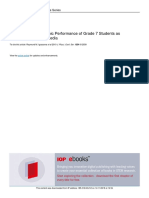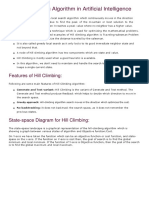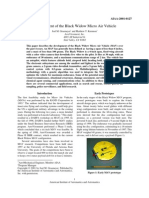UNIVERSITY OF ZIMBABWE
CENTRE FOR TEACHER EDUCATION AND MATERIALS
DEVELOPMENT
MORGENSTER TEACHERS COLLEGE
RESEARCH AND INNOVATION
GENERAL AND ECD
RESEARCH AND INNOVATION NOTES- INTAKE 29
QUANTITATIVE RESEARCH APPROACH
What is quantitative research?
It is a systematic investigation of phenomena (problem) by gathering
quantifiable data and performing statistical, mathematical or
computational techniques (Creswell, 2014).
It involves collecting and analyzing numerical data.
Characteristics of quantitative research
Contain measurable variables (e.g. age, number of family members,
salary range, highest education etc)
Use standardised research instruments (Structured tools) -
questionnaires, structured observation or experiments.
Assume a normal population distribution - To maintain the data reliability
of a quantitative research methodology, we assume that the population
distribution curve is normal. This type of population distribution is
preferred over a non-normal distribution as the sample size is large and
the characteristics of the sample vary with its size.
Present data in tables, graphs or figures
Use repeatable methods
Can predict outcomes
Use measuring devices
Generalisation of results
Types of quantitative research
Descriptive research - aims to explain the current status of an identified
and measurable variable (can explain and interpret- current status of
customer satisfaction, settings, conditions, events). It is not mandatory for
the researcher to have a hypothesis right from the start.
Correlational reseach - correlation research is conducted to establish a
relationship between two closely-knit entities and how one impacts the
other, and what changes are eventually observed.
Quasi-experimental research (Causal-comparative research) - is not
restricted to the statistical analysis of two variables but extends to
analyzing how various variables or groups change under the influence
of0ne changes
Experimental reseach (True experimentation) - is usually based on one or
more theories. In experimental research, an analysis is done around
proving or disproving the statement
Quantitative instruments/tools
� Questionnaires
Structured observations or experiments
Sampling methods
There are two main sampling methods for quantitative research:
Probability and Non-probability sampling (Cohen et al., 2014)
Probability sampling
Participants of a sample are chosen by random selection processes.
Each target audience member has an equal opportunity to be selected in
the sample.
Types of Probability sampling
Simple random sampling - random selection of elements for a sample.
Usually where the target population is considerably large.
Stratified random sampling - large population is divided into groups
(strata) and members of a sample are chosen randomly from these strata.
The various segregated strata should ideally not overlap one another.
Cluster sampling - the main segment is divided into clusters, usually using
geographical segmentation and demographic segmentation parameters.
Systematic sampling - is used to choose the sample members of a
population at regular intervals.
Non- Probability
Is where the researcher’s knowledge and experience are used to create
samples.
Because of the researcher’s involvement, not all the target population
members have an equal probability of being selected to be a part of a
sample.
Types of non-probability models
Convenience sampling - elements of a sample are chosen only due to one
prime reason: their proximity to the researcher. These samples are quick
and easy to implement as there is no other parameter of selection
involved.
Quota sampling - researchers can select elements using their knowledge
of target traits and personalities to form strata. Members of various strata
can then be chosen to be a part of the sample as per the researcher’s
understanding.
Snowball sampling- conducted with target audiences who are difficult to
contact and get information. It is popular in cases where the target
audience for analysis research is rare to put together.
Data analysis
Descriptive analysis- This method works perfectly for complete selections
of summarized numerical data sets. It shows means and deviations in
continuous data sets and frequencies and percentages in categorical data
sets.
� Inferential Analysis - This method is used where samples are derived from
complete research data. The researchers can choose different
conclusions even when they analyse the same comprehensive data set.
Readings
Borg, R.W. & Gall, M.D. (2013). Educational Research an Introduction.
University of Oregon: Pearson.
Cohen, L., Manion, L. & Morrison, K. (2014). Research Methods in Education
(8th). London: Routledge.
Creswell, J. W. (2016). Advances in mixed methods research. Webinar-
mixed methods international research association. Michigan
Mixed Methods Research and Scholarship Program University of
Michigan.www.caqd.org
Creswell, J. W. (2014). Research design: Qualitative, Quantitative and Mixed
Methodology. Thousand Oaks: SAGE.
Compiled by
Dr Mashoko D








